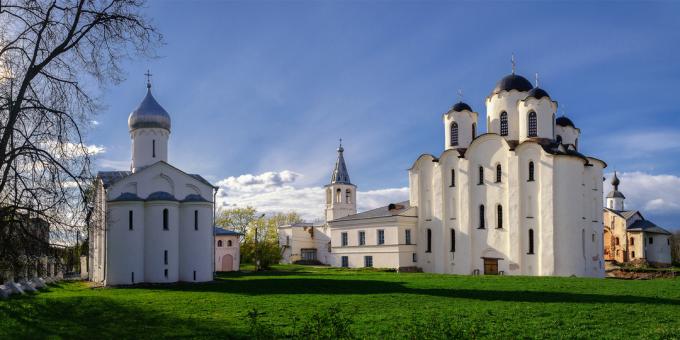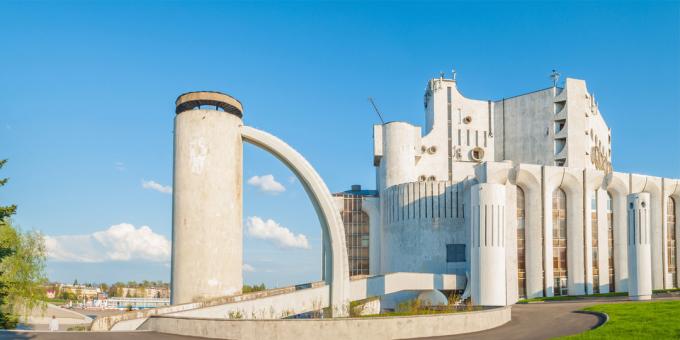Where to go and what to see in Veliky Novgorod - Lifehacker
Travels / / December 30, 2020
Table of contents
- Where to stay
- What sights to visit in Veliky Novgorod
- What sights to visit in the vicinity of Veliky Novgorod
- Where else to go in Veliky Novgorod
- What to bring from Veliky Novgorod
Where to stay
There are several hostels in Veliky Novgorod. A bed at a price of 480 rubles is offered by hostels Sleep & Go and "Yaroslav». You can also take a family room for 1,500 rubles.
Average price for a stylish apartment on Airbnb - straight opposite the Kremlin or 200 meters from him - is approximately 2,500-3,000 rubles. In the historic center, you can find options and simpler - for 1,500-2,000 rubles.
The standard price for a single or double room in Novgorod hotels is 2,000-2,500 rubles. Such prices are offered by the hotels built in Soviet times, but with modern interiors "Russia», «Intourist», «Sadko», «Volkhov». For those who like to travel with special comfort and are not too tight-lipped, there are designer hotels.Truvor"And"Rachmaninov", Four-star"Park Inn"And the new apart-hotel"Sofia
"With a view of the Novgorod Kremlin. Rooms in these hotels cost an average of 4,000-5,000 rubles.What sights to visit in Veliky Novgorod
Novgorod Kremlin

The main and most famous historical landmark of the city. The Kremlin is sometimes called Detinets, but residents of Novgorod rarely use this word.
The Kremlin was builtNovgorod Kremlin - Detinets in the XI century and at first it was wooden. It housed the residence of the Novgorod bishop, while the prince lived on the other side of the Volkhov River. The fortress acquired its present appearance in the 15th century. After Novgorod joined the Moscow state Ivan III thoroughly rebuilt Detinets.
Inside, you can visit the Children's Museum Center - a two-story building in the southern part of the Kremlin (Sudeiskiy town, d. 3), where the museum-reserve organizes exhibitions, lectures and educational thematic games for children.
The Kremlin is also interesting as a center of vantage points. You can buy tickets to the Sofia Belfry, from which it is convenient to admire the Yaroslav's Court on Torgovaya to the side, on the "battle passage" of the Kremlin and the highest tower Kokuy, from where a panoramic view of the city opens. By the way, the view from the Kokuy tower is depicted on the 1997 five-ruble bill.
Several attractions located on the territory of the Kremlin deserve special attention.
Sophia Cathedral

This is the oldest Orthodox stone cathedral in Russia - built in 1045-1055. It containsSt. Sophia Cathedral (Novgorod) - "Wikipedia" the icon "The Sign of the Most Holy Theotokos", especially revered by the Orthodox, which is considered miraculous, is the relics of several saints, including Anna, the wife of Yaroslav the Wise. In front of the altar, pay attention to the cross with a dove. According to legend, the dove turned to stone from the horrors that the guardsmen of Ivan IV the Terrible did.
Faceted (or Lord's) Chamber

One of the oldest surviving civil buildings in Russia. Gothic building erectedSovereign Palace of Facets in the 15th century with the participation of German masters. Inside are vaulted halls and underground galleries. In them, the Novgorod ruler (archbishop) received guests, organized social events and held courts.
Admission for adults costs 250 rubles, but in the summer of 2020 the Faceted Chamber is closed for renovations, so you can only admire it from the outside or with the help of virtual tour.
Public places

Large building in classical style, built for the state authorities of the Russian Empire at the end of the 18th century. Now it houses several large expositions of the Novgorod Museum-Reserve. With their help, you can learn about the history of Novgorod, archaeological research, the traditions of Russian icon painting and medieval carved craft.
Monument to the Millennium of Russia

The main Russian monument dedicated to the history of Russia from the moment of calling Rurik in 862 to the reign of Emperor Alexander II. In 1862 it was openedMillennium of Russia - "Wikipedia" in the presence of the emperor.
The authors are sculptors Mikhail Mikeshin and Ivan Schroeder, architect - Victor Hartman. The monument is made in the form of a ball-state and a bell, around which 128 historical figures are located in three tiers, which played the greatest role in the history of the Russian State. Among them are educators, statesmen and military leaders, writers, poets, artists and composers. You can walk around the monument for a long and leisurely stroll, examining and recognizing historical figures.
Yaroslav's courtyard
Address: the space between Bolshaya Moskovskaya, Nikolskaya and Ivanskaya streets and the Volkhov river.

The territory opposite the Kremlin, on the other bank of the Volkhov, was used in the old daysYaroslav's Dvorishche for trade, including international. Therefore, it is now called the Trade (the opposite area is Sofia). The Gothic and German Courtyards were located here, and the Chamber of Weights and Measures in the Church of St. John on Opoki.
Many churches have survived in the courtyard, money for the construction of which was donated by wealthy merchants, and on the site of the Nikolo-Dvorishchensky Cathedral, probably, there was the residence of Yaroslav the Wise. Later, during the period of the Novgorod Republic, a veche was formed at the Yaroslav's Court - an organ of city self-government. The arcade on the banks of the Volkhov is the remains of the Gostiny Dvor, which stood here before Great Patriotic War.
Now Yaroslav's Dvorishche is one of the best places in Veliky Novgorod for quiet walks away from noisy bars and bustling amusement parks.
Gate tower of Gostiny Dvor

The civil structure of the 17th century served as the entrance to the Gostiny Dvor, and now it houses the museum Christian art metal of the XI-XIX centuries. Here you can see washstands, censers, icon lamps, icons, pectoral crosses and many other religious items. The upper tier offers a picturesque view of the buildings of the Yaroslav's Court.
What sights to visit in the vicinity of Veliky Novgorod
Rurik's settlement

To the southeast of the city there is a settlement, which since the 19th century has been called Rurikov. It is consideredRurik's Settlement the residence of the first Novgorod princes, including Rurik, who was called up in 862 to end internecine strife in Russia. Archaeologists have foundPLANIGRAPHY AND CHRONOLOGY OF THE ANCIENT STAGES IN THE LIFE OF RYURIKOV CITY ON THE MATERIALS OF RESEARCH 2013-2016 it contains the remains of an early medieval settlement and more ancient evidence that people lived here since the Iron Age.
Now the settlement is only a hill from which beautiful views of the city and the Yuryev Monastery open. On the hill itself are the remains of the Church of the Annunciation of the 12th century preserved by archaeologists with inscriptions in Glagolitic found on its walls.
Yuriev Monastery and Museum of Wooden Architecture "Vitoslavlitsy"

In the village of Yuryevo there is one of the oldest Orthodox monasteries in Russia, which in the Novgorod Republic was consideredYuriev Monastery - "Wikipedia" spiritual center and served as the burial vault of noble townspeople. In 1119, the stone St. George Cathedral was laid here.
The monastery is active, and not all of its territory is open for visiting. Near the monastery is beach, where swimming is officially allowed in summer. The beach overlooks the source of the Volkhov River and Lake Ilmen.
Not far from the monastery there is a large the museum wooden architecture "Vitoslavlitsy". Village houses and outbuildings of the 19th-20th centuries, as well as older churches and chapels are assembled on its territory. In the houses there are exhibitions devoted to rural life. Festivities are held on the territory of the museum for Christmas, Christmastide, Maslenitsa, Spasy and other Orthodox holidays. Now the museum is under restoration, some objects are closed to the public.
Church of the Transfiguration of the Savior on Nereditsa

The temple in the village of Spas-Nereditsy, famous for the frescoes of the late 12th century, was destroyedChurch of the Transfiguration of the Savior on Nereditsa. XII century. in 1941 and was one of the first restored. Archaeologists are still looking for fragments of the fresco, which they carefully return to the walls of the temple.
Due to the danger of damaging the frescoes, the entrance to the temple is carried out one by one or as part of a family of up to five people. And only in good weather: a special microclimate is preserved inside, and snow or rain can disturb it.
Varlaamo-Khutynsky Spaso-Preobrazhensky Monastery and the grave of Gabriel Derzhavin

In the village of Khutyn, 9 km from Veliky Novgorod, there is one of the first monasteries founded by Saint Varlaam of Khutynsky. The monastery appearedKhutynsky monastery - "Wikipedia" in 1192 and was one of the richest in the Northwest. Here, in the Transfiguration Cathedral, the poet and statesman Gavriil Derzhavin is buried.
The monastery is interesting not only as a shrine, but also as a garden and park area, where roses of all sorts of shades bloom in summer.
Nikolo-Vyazhischsky monastery

Buildings basedHistory of the monastery in 1411, the monasteries in the village of Vyazhischi look rather unusual for the Novgorod region and are more like the churches of the Volga region. The large churches of St. Nicholas the Wonderworker and St. John the Theologian are decorated with multi-colored tiles, there is a lot of green in the design. A female monastery, active.
Where else to go in Veliky Novgorod
Center for Musical Antiquities named after V. AND. Povetkin
Address: st. Ilyina, d. 9B.

A small wooden building is located in the courtyards of the so-called Old Town on the Torgovaya Side, not far from Yaroslav's Dvorishch. This music reconstruction center - the only one in Russia.
Novgorod archaeologists regularly find the remains of musical instruments: horns, jew's harps, gusli, even bagpipes. And thanks to the reenactors, we now know how they all sounded. Unfortunately, it is not known for certain what kind of music they played in the Middle Ages. But based on the tunes collected by researchers in Russian villages in the 19th and 20th centuries, one can at least roughly imagine what music was like before the invention of musical notation. For organized groups, the center conducts lectures and concerts.
Academic Drama Theater named after F. M. Dostoevsky
Address: st. Velikaya, d. 14.

Theater it is interesting not so much for its performances (the repertoire is quite standard for a provincial theater), as for its extraordinary appearance. This futuristic building was built in 1987. In its creation was notedNovgorod Drama Theater named after F. M. Dostoevsky Andrei Makarevich, who, during its design, received the profession of an architect. However, the role of the musician is often exaggerated: the real creator of the theater is the architect Vladimir Somov.
The area around the theater was neglected for a long time, but in 2021 a new park will appear here, designed by KB Strelka and the architectural studio 8 Linii.
Theater for children and youth "Maly"
Address: ave. Mira, d. 32A.

«Small", Located in the residential Western district, rather the opposite of a drama theater. In an inconspicuous building, strong chamber performances are staged, for example "A Novel in Letters to Maria Tsvetaeva and Rainer Maria Rilke". And every two years in the spring, the Tsar-Fairy Tale international festival is held, a well-known event in the theater world.
Now the theater troupe is preparing for the opening of the new season, the poster has not yet been published.
Cinema Museum of Valery Rubtsov
Address: st. Rogatitsa, d. 16/21.

Valery Rubtsov is a Novgorod collector of 20th century film technology. He turned his meeting into private museum. It displays dozens of cameras, projectors, editing equipment and related items. A separate exposition is dedicated to amateur video equipment.
The museum conducts lectures on the art of cinema and the history of cinema, acoustic concerts of Novgorod groups and film screenings, including retrospectives of the Soviet and world movie.
Novgorod Center for Contemporary Art
Address: st. Bolshaya Moskovskaya, d. 37/9.

Center for Contemporary Art located in the cultural center "Dialogue". It is not difficult to find the entrance: there are many art objects, graffiti, benches with images of Malevich and Kandinsky around it. A new exhibition wave opens in the center every month. In addition to the works of Novgorod artists, photographers and artisans, it hosts traveling exhibitions from other cities and countries.
Old city
Address: between Nutnaya, Pankratova, Fedorovsky Rucheom and Bolshaya Moskovskaya streets.

Historically, the Old Town is the Slavensky end on the Torgovaya side, one of the settlements that made up ancient Novgorod. Now it is a territory with two or three-storey buildings of the 19th and 20th centuries, as well as a private sector - a quiet and atmospheric place to walk and look at unusual houses and old courtyards.
On the outskirts of the Old Town, the Kolobok cafe (st. Bolshaya Moskovskaya, d. 28) is a small and canteen-like establishment serving delicious hodgepodge and fish soup with red fish, and you can take with you inexpensive and delicious pies.
Cafes and bars
View this post on Instagram
Publication from Restaurant House Berg (@dom_berga)
Next to Kolobok, in a renovated historic building, there is a merchant cuisine restaurant “Berg's House”. A more democratic bistro operates under him. A 10-minute walk, on Fedorovsky Ruchey street, 9/17, near the Alexander Nevsky bridge, there is a cozy craft beer shop Samovar - Hundreds of bottled beers and ciders, 14 taps, homemade furniture and vinyl records. The assortment of the bar is constantly changing, and its patrons are the Novgorodian creative intelligentsia, fashionable youth and an aging punk crowd.
If you walk along Bolshaya Moskovskaya to house 31/7, you can visit the wine cafe "Time H». The author of the project has selected a relatively inexpensive and interesting wine cellar and offers visitors European cuisine typical of wine-growing regions.
The Sofia side, in turn, is replete with themed bars. Rock club "Dad bar"(St. Chudovskaya, 4) offers live concerts from Thursday to Sunday and crazy night parties on weekends. There is also an Irish pub Greensleeves (st. Musa Jalil-Dukhovskoy, 23A), British pub Mycroft (st. Predtechenskaya, 13/6) 5 minutes walk from the Kremlin and cafe "Telegraph"(St. Lyudogoschaya, 2) overlooking the main square of the city. And on the territory of the once famous all over the country distillery "Alkon" is a bar ZAVOD. It is interesting for its huge selection of homemade berry and herbal liqueurs with vodka and gin and dishes from the Russian oven.
What to bring from Veliky Novgorod
Delicious souvenirs
There is traditionally a lot of fish in the Novgorod cuisine, therefore, even on the coat of arms of the city, right under the bears, whitefish fish are painted. A famous Novgorod snack is smelt, a small dried fish from Lake Ilmen. Also Novgorodians eat pike perch and pike. They can be found in the fish shop on the Central Market (st. Prusskaya, 15).
There is an alcoholic souvenir shop in the building where the ZAVOD bar is located. For lovers, we recommend Novgorod gin, Sadko vodka, Old Russian balsam or Spotykach sweet liqueur with prunes and blueberries. Several types of willow tea, honey and pine cone jam are also sold here.
You can also buy delicious souvenirs at the Krasnaya Izba tourism office at Sennaya Ploschad, d. 5 or on website. Among other things, in "Krasnaya izba" they sell porridge made of flax - a traditional Novgorod culture for 100 rubles. And for 350 rubles you can buy a face mask based on sapropel mud from one of the glacial lakes of the Novgorod region.
Various trinkets
As for the beautiful trinkets that will remind you of your journey, you can find a large number of them in the souvenir rows on Sennaya Square near the Kremlin Park. We especially recommend taking a closer look at birch bark products - baskets, breadbaskets or children's toys - because it is largely thanks to her that we know so much about the history of Novgorod.
Novgorod is the city of the veche republic, and the bell is the symbol of the veche. In Veliky Novgorod, small brass bells are still being produced, which can be bought in any souvenir shop.
An art gallery is located in the Kremlin Park between Sennaya Square and the Kremlin, where you can buy paintings local artists. And on the Yaroslav's Dvorishche, in the "Gallery on the Marketplace" (st. Ilyin, 2), sell cute magnets and postcards with watercolor drawings.
Products with cross stitching
The sacral stitching is a traditional technique of embroidery on linen products: clothes and scarves, table napkins and tablecloths, art panels. In 1929 it was opened company in the village of Kresttsy, after which the Kresttskaya line became one of the symbols of Russian folk textiles and fell into gift sets that Soviet leaders presented to leaders of other countries.
The factory still sews custom-made clothes and home textiles. In the "Red izba" and the souvenir shop "Earth Novgorodskaya is alive" (st. Prusskaya, 1), you can buy small scarves, napkins or souvenir embroidery. And in the store at the factory itself in Kresttsy (st. Novokholovskaya, 6) you can also buy clothes - for example, dresses and shirts.
Read also⛪🏠🏨
- Where to go and what to see in Kaliningrad
- Where to go and what to see in Ryazan
- Where to go and what to see in Vladivostok
- Where to go and what to see in Volgograd
- Where to go and what to see in Yaroslavl



